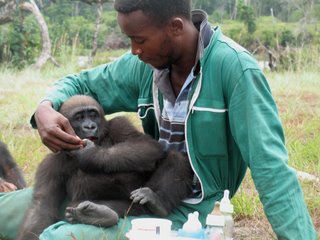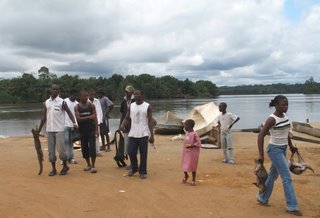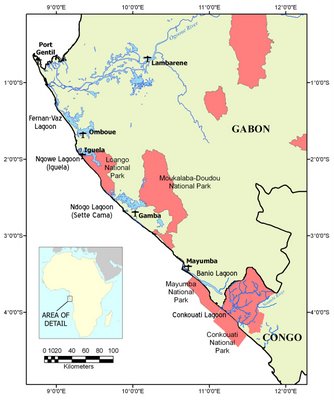Mamiwata is an African name for a spirit believed to be embodied by the manatee. This blog chronicles my search for the elusive African manatee, and my exploration to understand its biology, habitat and preservation needs, economic and cultural significance. So little is known about this animal, yet it is intensely hunted almost everywhere it exists and may already be gone from much of its previous range. In 2006 I was inspired to go find and study them, starting in Gabon.
Saturday, September 30, 2006
On most of the pictures I'm posting, you can click on them to see a larger version. This will help with the bird and animal pictures where it looks like a spec! Sorry, I don't have a National Geo quality lens and the wildlife doesn't get as close as I'd like... or else it's not safe for me to get any closer to them!
And for those of you new to blogs: at the end of each posting, you can click on Comments and write a note if you have a question, need an explanation, etc.
Sorry, my posting was cut short yesterday because I had to leave Libreville and catch a plane down the coast to Iguela, which I'll write about shortly. I wanted to share a few more images from Evaro:

Fresh manatee feeding sign in a cove off Lake Evaro. The grass is matted down where the manatees push it down and feed further in. We returned to this spot at night and spooked an animal here (we didn't mean to spook it, they are just incredibly shy and flee). In other parts of Africa manatee feeding sign is twisted grass stems, but I'm not seeing that here and none of the former manatee hunters I've spoken with have ever seen such a thing.

A young female Situtunga. This one is part of a captive breeding program at Evaro.

This is Steve (the person) with Chemaine (the gorilla) having breakfast. Steve spends everyday with the orphan gorillas, caring for them and taking them into the forest to learn how to eat native plants. Once the gorillas are older they will move to their own island in the lake. There is also a chimp island in the lake with 2 adults who are former orphans/pets.

Chemaine (aged 3 years) and Charlemagne (chimp, not sure of age). Spending time with these guys momentarily made me want to give up marine mammals and devote my life to working with gorillas! They are absolutely incredible.

Dejeuner (lunch). Robert and Jean-Marc manage Evaro Lodge and are dedicated to protecting the area's wildlife, as well as providing an income for the local people by providing jobs and purchasing local products (which in turn helps reduce hunting pressure). The meals were all incredible, and the food is locally grown or caught (fish). Jean-Marc is working to try to raise some funds for wildlife research projects there including manatee work (keep your fingers crossed). I highly recommend Evaro as a vacation destination for fantastic wildlife viewing!
Friday, September 29, 2006
 Evaro
EvaroAfter a night in Lambarene (at a very nice hotel on the river that had monkeys and some antelope called Situtunga), Nic and I were met by a boat and taken to Evaro Lodge. The owners of the lodge, which is located on a lake south of Lambarene, are very interested in supporting wildlife research and manatee work in particular. Evaro Lodge sits on a peninsula that sticks out in Evaro Lake, and it looks like something from "Out of Africa". Truly a fantastic place with a pool and a huge vegetable garden. They have a gorilla and chimpanzee orphange. We arrived and were met by porters and a bartender with welcome cocktails, and I swear I thought at any moment someone was going to say "Welcome to Fantasy Island!"
 The lodge sits on the small peninsula just above and to the right of the word "Evaro" on the map above. We found manatee feeding sign all around the lake. We went and sat at one location at night and saw 2 manatees (might have been the same animal twice).
The lodge sits on the small peninsula just above and to the right of the word "Evaro" on the map above. We found manatee feeding sign all around the lake. We went and sat at one location at night and saw 2 manatees (might have been the same animal twice). 
The cottage I stayed in at Evaro. The palm tree is loaded down with nests of Village Weaver birds.
The fabulous pool... I have dreams of sighting manatees on the lake from the pool! Just kidding Buddy!
After Kango, Nic and I travelled to Lambarene, a larger town on the Ogooue River and the fishing capital of Gabon. South of Lambarene there's a series of large lakes (if you scroll down to my Sept. 17 posting, you can see Lambarene, the river and the lakes near the top of the map). It's a freshwater system; there isn't much fishing in the ocean here. The market at Lambarene also always has bushmeat, and there have been many records of manatee meat showing up there. We walked around the market and saw bushmeat, but no manatee. People are suspicious of the presence of a white woman and we were asked several times if we were the police. So people would say "maybe tomorrow" or "only in the rainy season".

Smoked fish and plantains for sale. There were also some beautiful fabrics in the market.

This photo is of small crocodiles (upper left), crocodile eggs and internal organs (on the pink bag) and antelope legs in the market. The guy selling this stuff was very angry at me for photographing it.

The Oguooe River at the end of the dry season. The water apparently comes up at least 3 meters during the rainy season, which gives manatees access to flooded forests to feed in.

The morning's bushmeat catch coming into the market at Kango. They have a small crocodile, a monkey and 2 porcupine-like animals. I must say it's hard to see first hand. Seeing it in a magazine in the states I think "what a shame", but here, seeing the huge numbers of animals coming into the markets each day from the forests, it's really depressing. I feel like they are just pillaging until there's nothing left. I have heard of a few places where there are no longer any large animals at all, but culturally it's the way they've always lived and they don't really have any other source of protein.

This is a very cool water monitor lizard we saw on the river.

Lunch at a local roadside cafe in Kango. They have the most wonderful cafe au lait in Gabon! And all meals are served with french bread. Here we're having omlettes complet which had petit pois (peas) and onions.
Thursday, September 28, 2006
It's been a busy week! On Sept. 21 Nic and I got a ride to a small town called Kango, about a 2 hour drive inland from the capital of Gabon, Libreville. Kango is located at the convergence of several rivers, and a couple years ago Nic and Tim photographed a manatee hunter there with a carcass. We were able to go back and interview the hunter, who of course claims all his catches are accidental. Manatee hunting is illegal here, but laws are rarely enforced. We hired a boat driver to take us out on the rivers. We went up several smaller rivers and after only about half an hour, as we came around a corner, the driver said he saw a manatee feeding. I didn't believe him because manatees are very shy here and are mostly only seen at night (because they are hunted), so I thought the guy was bluffing us because we were paying him to find us manatees. We stopped the motor and after about 5 minutes a big snout popped up about 10 feet from the boat! I couldn't believe it. Then a few minutes later a Mom and calf surfaced next to the other adult! Very exciting and surprising to see them during daylight in an area where they are hunted. So my fears of coming to Africa and not seeing any manatees are over! After the second time the manatees surfaced, they moved off down the river (saw bubble trail) but the water was so muddy we never saw them again. I did manage to get 1 picture of the tip of a nose, but people here are joking me that they've seen better pictures of the Loch Ness monster! So you'll just have to take my word for it until I get something better.

(Little nose sticking up on the right, tail swirl on the left)
That night we camped at our boat driver's family's fishing camp in the forest. They were Fang people, the largest tribe in Gabon. They had a few tin shacks on the river, some fishing nets and a couple pots and pans, yet they had a cell phone! It was quite an experience camping in the forest and hearing all the animal sounds. I found out later that they were formally cannibals, and I'm glad I didn't know that at the time!
The internet is painfully slow here, so I'm going to try to post more photos later!
Wednesday, September 20, 2006
My week here has flown and I wish I could stay longer! Below are a few more pics from my very nice stay here!
 The living & working quarters at Mayumba national park
The living & working quarters at Mayumba national park Jacquie & Simon on the boat
Jacquie & Simon on the boat
 Ant (short for Anthony!) with his barracuda
Ant (short for Anthony!) with his barracuda
 Tim in his happy place.
Tim in his happy place. Pretty butterfly from the forest.
Pretty butterfly from the forest.
Today I'm flying to Libreville, tomorrow Nick and I will start a week of travel to Kango and Lambarene (in the interior) where there is the biggest market for manatee meat in Gabon. We will do market surveys and interview fisherman, hopefully get some genetics samples, as well as do some boat surveys of the river and very large lake. I don't think I'll have much internet access for the next week or so, but will post more news and pictures when I can. Cheers!
Tuesday, September 19, 2006

Banio Lagoon
Just returned from 2 days of surveying all the major rivers on this lagoon. Stayed in this wonderful house with lagoon on one side, beach on the other and savannah all around it. Ate a wonderful salad from the garden. One bummer- I walked out t o the beach and found alot of fresh oil. There are alot of oil rigs off the coast here (they are so close you can see their lights at night) so oil spills are inevitable.

Duiker feeding under the house. They're like small deer.
 Plenty of manatee fodder in the lagoon, but didn't see the elusive beasts. I think I need 6 months here and a kayak. The lagoon is 75km long, so the point of the surveys this week was mostly to get a sense of the place and look for suitable habitat and feeding sign.
Plenty of manatee fodder in the lagoon, but didn't see the elusive beasts. I think I need 6 months here and a kayak. The lagoon is 75km long, so the point of the surveys this week was mostly to get a sense of the place and look for suitable habitat and feeding sign.
At the mouth of the first river we visited this morning, there were literally thousands of fruit bats flying around. They are adorable- like little flying dogs. Definitely one of the coolest things I've ever seen. I only wish the light had been a bit brighter. If you've noticed that all my pics are grey, it's because the rainy season is about to start and the cloud cover will stay this way until it does. They say after rainy season begins the sky will clear up and be blue again... somewhat counterintuitive, but I'm looking forward to it.


Every river has logs fallen across, so at some point our boat couldn't continue. This is why I need the kayak. I'm sure manatees are up there, happy that none of the humans can reach them.
 We saw 4 forest buffalo at the end of today. Yes, the brown lumps are them. Unfortunately this is the only shot I got before my camera bettery died. I'll try to do better next time!
We saw 4 forest buffalo at the end of today. Yes, the brown lumps are them. Unfortunately this is the only shot I got before my camera bettery died. I'll try to do better next time!Good night!!!
Monday, September 18, 2006
Today I'm heading to a remote camp today for 2 days... it's actually a beautiful house on the lagoon with the ocean on the other side & a fresh veggie garden (a real luxury here). They say there's a gorilla troop nearby that comes right up to the house in the morning, and forest elephants on the beach. I'll be surveying a couple rivers near there, so wish me luck (although manatee sightings are so infrequent here I don't expect to actually see one... feeding sign would be exciting).
Back on Tues night!
Here's my best bird pic so far- a Woodland Kingfisher.

Sunday, September 17, 2006
 Juvenile Green Sea Turtle
Juvenile Green Sea Turtle Yesterday a fisherman brought in a live sea turtle that had accidentally gotten caught in his net. Pictured at left is Solange Ngoouessono, the Gabonese manager of Mayumba national park, with Tim and the fisherman (in yellow). It's great that he reported the turtle. Unfortunately it was covered in fibropapilloma tumors, which are now frequently seen in sea turtles worldwide. It had a tumor in each eye, which unfortunately will grow over the eyes until the turtle is blind. We took off several tumors from the flippers for analysis and took basic measurements. Faced with the choice of euthansia (which here means someone would have to cut it's head off with an axe) or releasing it, we decided to put it back in the ocean. It will not survive long-term (the tumors will continue to spread all over it's body and once it goes blind the turtle is likely to starve), but it is the beginning of the nesting season here and so hopefully she will lay a clutch of eggs. Once we brought her down to the ocean she sped off which was great, because she had been quite lethargic after probably hours caught in a net, hours of sitting in a truck and then having tumors sliced off.


Click here for more information on fibropapilloma tumors.
Saturday, September 16, 2006
 Nick and the former manatee hunter, Soami at a tower the EcoGuides have built for offshore observation.
Nick and the former manatee hunter, Soami at a tower the EcoGuides have built for offshore observation. 
The beach off Mayumba. We saw buffalo tracks everywhere and there are lowland gorillas here too. Didn't see one yet though- you'll know when I do!
 Nick and I (with driver Papa) surveying a river where Soami tells us is best in the area for manatees. Unfortunately fallen logs across it prevented us from going as far up as we wanted.
Nick and I (with driver Papa) surveying a river where Soami tells us is best in the area for manatees. Unfortunately fallen logs across it prevented us from going as far up as we wanted.
Friday, September 15, 2006
After 7 months of planning and 33 hours of travel, I arrived in Libreville, Gabon (the capital) about a week ago. On the way I had a 10 hour layover in Casablanca, Morocco and was able to see a bit of the city including a breath-taking mosque.

The second largest mosque in the world.
I spent 2 days in Libreville and then flew down the coast to Mayumba to meet up with my colleague Tim Collins, who heads up a humpback whale research team there. Mayumba is the southernmost national park in Gabon, with the country's only marine protected area off the coast.
My first day here I went out with Tim's team to see the humpbacks, since it's getting near the end of the whale season here. We had an incredible day and saw whales everywhere!
(Above) A biopsy dart hits it's mark.
The whale team: Simon (boat driver and whale researcher, from South Africa), Nick (grad student who will do manatee genetics, from Gabon), Tim (humpback field biologist extraordinaire) and Jackie (grad student working on humpback genetics, from Peru). This day Tim got his highest number of biopsy samples in one day of the whole season. For you non-biologists, the biopsy dart is shot from a bow, it hits the whale taking a small cylindrical plug of tissue, then bounces off into the water where it is collected.
We are all staying in a house that combines office and living quarters near the beach. Yesterday I did a survey tour of Banio lagoon (which is about 75km long, but only ~1km wide) and interviewed a former manatee hunter who is now working for the national park here as an EcoGuide (ranger). There are many rivers off the lagoon that seem to be good manatee habitat, I could spend 6 months just here.
I'll write more soon.... since I don't spend much time at the computer I'll likely post more pictures than text in the coming weeks. But I'll try to include most of the great stories!







